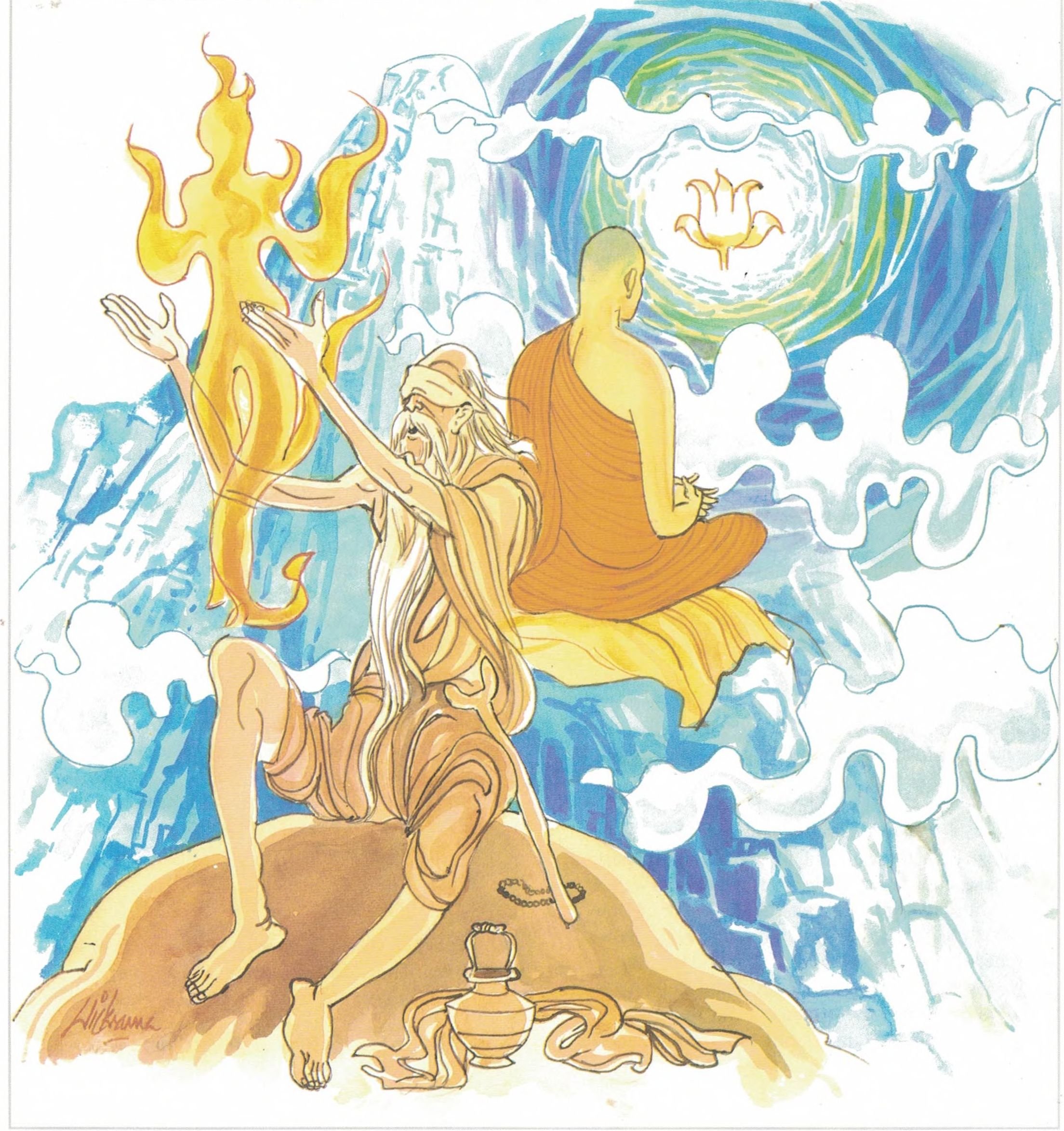Dhammapada (Illustrated)
by Ven. Weagoda Sarada Maha Thero | 1993 | 341,201 words | ISBN-10: 9810049382 | ISBN-13: 9789810049386
This page describes The Story of Nun Kisagotami which is verse 114 of the English translation of the Dhammapada which forms a part of the Sutta Pitaka of the Buddhist canon of literature. Presenting the fundamental basics of the Buddhist way of life, the Dhammapada is a collection of 423 stanzas. This verse 114 is part of the Sahassa Vagga (Thousands) and the moral of the story is “A day’s life seeing the deathless is greater than a hundred years without seeing it”.
Verse 114 - The Story of Nun Kisāgotami
Pali text, illustration and English translation of Dhammapada verse 114:
yo ca vassasataṃ jīve apassaṃ amataṃ padaṃ |
ekā'haṃ jīvitaṃ seyyo passato amataṃ padaṃ || 114 ||
114. Though one should live a hundred years not seeing the Deathless State, yet better is life for a single day seeing Deathlessness.
 A day’s life seeing the deathless is greater than a hundred years without seeing it. |
The Story of Nun Kisāgotami
While residing at the Jetavana Monastery, the Buddha spoke this verse, with reference to Kisāgotami.
Kisāgotami was the daughter of a rich man from Sāvatthi; she was known as Kisāgotami because of her slim body. Kisāgotami was married to a rich young man and a son was born to them. The boy died when he was just a toddler and Kisāgotami was stricken with grief. Carrying the dead body of her son, she went about asking for medicine that would restore her son to life from everyone she happened to meet. People began to think that she had gone mad. But a wise man seeing her condition thought that he should be of some help to her. So, he said to her, “The Buddha is the person you should approach, he has the medicine you want; go to him.” Thus, she went to the Buddha and asked him to give her the medicine that would restore her dead son to life.
The Buddha told her to get some mustard seeds from a house where there had been no death. Carrying her dead child in her bosom, Kisāgotami went from house to house, with the request for some mustard seeds. Everyone was willing to help her, but she could not find a single house where death had not occurred. Then, she realized that hers was not the only family that had faced death and that there were more people dead than living. As soon as she realized this, her attitude towards her dead son changed; she was no longer attached to the dead body of her son.
She left the corpse in the jungle and returned to the Buddha and reported that she could find no house where death had not occurred. Then the Buddha said, “Did you not get the single pinch of mustard seed?” “No, that did I not, Venerable. In every village the dead are more in number than the living.” Said the Buddha, “Vainly did you imagine that you alone had lost a child. But all living beings are subject to an unchanging law, and it is this: The prince of death, like a raging torrent, sweeps away into the sea of ruin all living beings; with their longings still unfulfilled. Gotami, you thought that you were the only one who had lost a son. As you have now realized, death comes to all beings; before their desires are fulfilled death takes them away.” On hearing this, Kisāgotami fully realized the impermanence, unsatisfactoriness and insubstantiality of the aggregates and attained sotāpatti fruition.
Soon afterwards, Kisāgotami became a nun. One day, as she was lighting the lamps she saw the flames flaring up and dying out, and suddenly she clearly perceived the arising and the perishing of beings. The Buddha, through supernormal power, saw her from his monastery, and sent forth his radiance and appeared to her in person. Kisāgotami was told to continue meditating on the impermanent nature of all beings and to strive hard to realize Nibbāna. She reached higher stages of spiritual awakening.
Explanatory Translation (Verse 114)
amataṃ padaṃ apassaṃ yo ca vassasataṃ jīve
amataṃ padaṃ passato ekāhaṃ jīvitaṃ seyyo
amataṃ padaṃ [pada]: Deathless state (nibbāna); apassaṃ [apassa]: without seeing; yo ca: if an individual; vassasataṃ jīve: were to live a hundred years; amataṃ padaṃ [pada]: the deathless state (nibbāna); passato [passata]: the perceiver’s; ekāhaṃ [ekāha]: one day’s; jīvitaṃ [jīvita]: life; seyyo [seyya]: is noble
A single day’s life of a person who sees the state of deathlessness is far greater and nobler than the hundred-year life-span of a person who does not perceive the deathless state.
Commentary and exegetical material (Verse 114)
amataṃ padaṃ: the state of deathlessness–Nibbāna. Nibbāna is characterized as ‘the deathless’ because it is the cessation of the illusion of existence. Nibbāna has to be won by depersonalizing the personalized five-fold totality (pancūpādāna khanda) of experience.
The self image of existence that we carry in our mind is created by the personalization of impersonal phenomena. Our existence or being is the continuation of this self image called personality. When we have removed this self image through depersonalization, we cease to exist. When we cease to exist, we cease to die. This is the deathless state. To observe the experience, as it comes and goes, without personalizing it, is to experience the deathless Nibbāna here and now.
